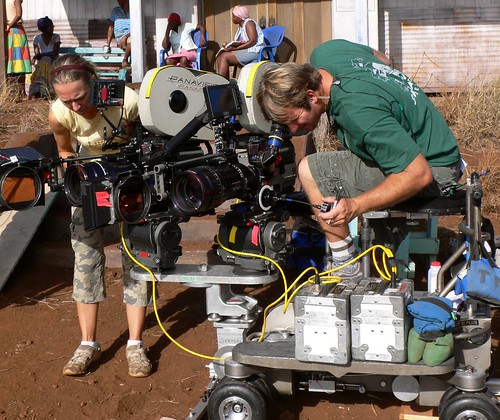Inspiration
Who can inspire more (someone will tell us) for telling stories in film than the great Hitchcock? The Ultimate Hitch Cookbook is a student project from the University of Applied Sciences and Arts in Hannover. An animated book containing recipes for Alfred Hitchcock’s classics.
Now Make Your Own Recipes!

cc licensed ( BY SA ) flickr photo shared by jai Mansson’s photography.
You’ve read movies and done your pre-work. Now it’s time to make movies! Video is perhaps the most rich of storytelling forms, and over the next two weeks you will focus explicitly on video storytelling. The only assignments for the next two weeks on your plate are to work on video assignments
You will want to be using the video editor that allows you to cut and re-arrange clips on a timeline, and to add, and layer audio tracks. Most typically this is the software that came with your operating system- iMovie on Macs and MovieMaker on Windows PCs (but feel free to look at some of the other options in the ds106 Handbook). Many of the assignments will require downloading of clips form YouTube (we have a tutorial if you need it). PC users may have challenges in importing the downloaded mp4 video files- you will either have to install codecs to read mp4 videos, or use a converter to change mp4 into AVI or WMV file formats.
It is also important to focus on the storytelling aspect of your video making–do not focus on just the technical points or making the video just for the stars… Be very sure that your videos tell a story somehow and that when you write up your blog post you are providing full details and context for your videos. Think about the shape of stories we studied in week 3.
Here is what you should be including in all of your video assignments for the next two weeks:
- An opening title sequence and closing credits – make sure your video gives credit to all media sources.
- Make good use of audio– keep in mind the lessons from audio storytelling- use of background music, sound effects, and/or foley.
- Your blog writeup includes the key elements— narrative describing the ideas/inspiration behind the video you created and also details on how it was made (including credits/links to media sources and at least one screen shot of your video editing screen).
Creating your videos is all you need to do for two weeks, no daily creates (Well we won’t stop you.), no reviewing other material. It’s video, video, video.
Video Editing Resources
Check the ds106 Handbook Tools section for options on video editing tools and links to tutorials for iMovie and Movie Maker. Other resources that may help include:
- UMW Digital Video developed by Andy Rush in DTLT, a local video guru
- Vimeo Video School
- The Basics of Video Editing: The Complete Guide
Bringing That Foley Assignment Back to Life
Do you remember your work in putting together the 30 seconds of foley sounds for the Charlie Chaplin Lion’s cage clip? Now you get to re-assemble it back into a new video, and try to make a story out of it.
Your new story can be an explanation of what he is doing in the cage, why he went in there, the story from the Lion’s point of view, or any other creative interpretation of this sequence.
You will first need to download the clip and remove the original audio sound track.
http://www.youtube.com/watch?v=79i84xYelZI
Add an original title sequence that sets up the scene and defines the story- include a new music sound track, it can be modern or old fashioned, but it should match the theme for your story. Add any other media that you think might help complete the story. The idea is to re-imagine it using your video editing chops.
Now download from SoundCloud segments of audio that your classmates created, re-assemble them to line up with the action in the video.
- Sounds from 00:00 to 00:30 (tag chaplin-lion-01)
- Sounds from 00:31 to 01:00 (tag chaplin-lion-02)
- Sounds from 01:01 to 01:30 (tag chaplin-lion-03)
- Sounds from 01:31 to 02:00 (tag chaplin-lion-04)
- Sounds from 02:01 to 02:30 (tag chaplin-lion-05)
- Sounds from 02:31 to 02:55 (tag chaplin-lion-06)
Note, we are aware of only two segments that were completed. (See Google Doc). So choose from some previous students, create your own, or use music to fill the space.
Add a closing credits sequence and anything to make the story complete. Publish it to YouTube. In your blog post for this assignment, use the tags for the video assignment based on this clip — VideoAssignments, VideoAssignments655
Are you able to make a different and new story out of this material? Try to do more than just putting media together, give The Tramp’s adventure with the Lion a new meaning.
The Rest of the Video Mission
Over the next two weeks, your other task is completion of 16 stars of assignments from the Video Assignments. If you don’t like these, feel free to create your own assignments and add them to the Assignment Bank.
All your video work should be uploaded to YouTube and write a post for each completed assignment in which you embed your YouTube video. We’d like to know the why’s and how’s of your productions.
Weekly Summary
Your week summary should not take much to do. Besides linking to the work you did for the last two weeks, make room to write some reflection on what you learned about creating stories in video — and not just the technical aspects, but what did you find were the compelling elements of story in the work you did in these two weeks.


Add a comment